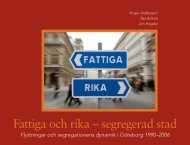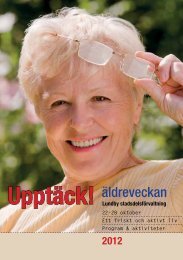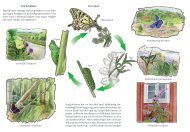Skiascope 1 som pdf - Göteborg
Skiascope 1 som pdf - Göteborg
Skiascope 1 som pdf - Göteborg
Create successful ePaper yourself
Turn your PDF publications into a flip-book with our unique Google optimized e-Paper software.
JeFF WerNer<br />
INledNING<br />
”Hängda och utställda” skulle kunna vara titeln på ännu en deckare.<br />
Men denna bok – den första i en ny vetenskaplig skriftserie från<br />
<strong>Göteborg</strong>s konstmuseum – innehåller förhoppningsvis mer spännande<br />
stoff än så. Det finns förvisso de <strong>som</strong> anser att konsten dör<br />
när den flyttar in på museum – vi kan kalla dem museiskeptiker<br />
– men för de allra flesta är det på museet <strong>som</strong> konsten föds. Det är<br />
där vi uppfattar målningen eller skulpturen <strong>som</strong> konst, renskalad<br />
från många andra av dess funktioner : att hylla makten, att tjäna Gud<br />
eller kyrkan, att höja ägarens status, eller att förse konstnären och<br />
konsthandlaren med en hygglig utkomst för nämna några exempel.<br />
Mot museiskeptikernas argument om museet <strong>som</strong> skarprättare, kan<br />
motsatsen anföras : museet <strong>som</strong> konstens förlösare. Vi <strong>som</strong> omfattar<br />
denna hållning kan peka på att museerna är jämnåriga med det<br />
moderna konstbegreppets födelse under slutet av 1700-talet. Och för<br />
1900-talets avantgarde-konst har många gånger museets potential att<br />
likt en demiurg omvandla skräp till guld varit avgörande för att få<br />
14<br />
JeFF WerNer<br />
INtroduCtIoN<br />
The first issue of a new scholarly periodical from the Gothenburg Museum<br />
of Art, Displayed and Exhibited, true to its penny dreadful title contains<br />
plenty of sensation, but of the aesthetic rather than the lurid variety. True,<br />
there are those who believe that art is killed stone dead when it is moved<br />
into a museum – we can perhaps call them museum sceptics – but for most<br />
of us museums are the place where art is born. It is here we understand<br />
painting or sculpture as art, peeled bare of many of its many other functions:<br />
the praise of power, the service of God or the Church, the flaunting<br />
of an owner’s status, or the provision of a livelihood to an artist or an art<br />
dealer, to name only a few. In answer to the museum sceptics’ conviction<br />
that museums are executioners, we can retort that museums are the midwives<br />
of art. We can point to the fact that museums are the same age as<br />
the very idea of art, a notion that dates to the end of the eighteenth century.<br />
And for the art of the twentieth-century avant-garde, the demiurge<br />
power of museums to transform trash into gold has always been crucial<br />
in defining artefacts and actions as art. Ever since Marcel Duchamp’s<br />
‘ready-mades’ in the 1910s, the capacity of art institutions to comprehend<br />
both artefacts and gestures as art has been an important element in artistic<br />
life. Museums of art are constantly called on to protect art: they preserve<br />
it from the ravages of time; they make sure it is not forgotten; and they<br />
defend its claim to be art in the face of critical objections.<br />
The hanging of fine art is thus far more a question of life than of<br />
death.<br />
Of course, it does sound very odd to talk of hanging art, as if it were<br />
an execution. In the West, during the boom in the nineteenth century<br />
when museums were constructed and fitted out on an immense scale,

















